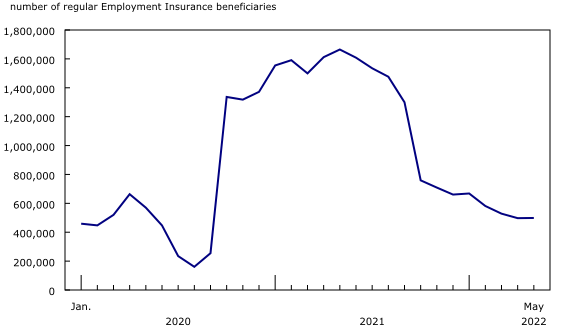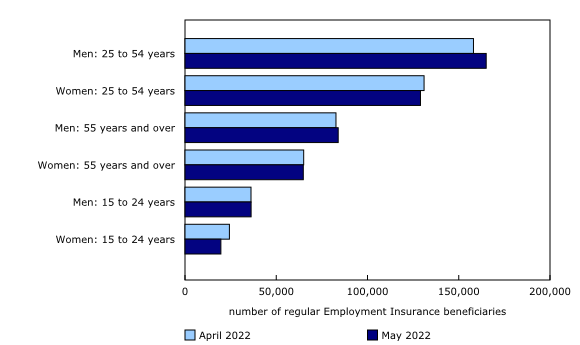Employment Insurance, May 2022
Released: 2022-07-21
In May, 499,000 Canadians received regular Employment Insurance (EI) benefits, little changed from April.
According to the Labour Force Survey (LFS), the number of unemployed people also held steady in May, with 1 million Canadians looking for work and an additional 87,000 who had a connection to a job, either because they were on temporary layoff or had arrangements to begin a new job in the near future.
The number of Canadians collecting regular Employment Insurance benefits held steady in May
The number of Canadians collecting regular EI benefits held steady in May, with an increase in Ontario (+5.3%; +7,000) being offset by decreases in Alberta (-6.8%; -4,000), Nova Scotia (-3.0%; -800), British Columbia (-2.4%; -1,000), and New Brunswick (-1.7%; -600). Meanwhile, in May, there was little month-over-month change in the number of regular EI beneficiaries in Quebec, Saskatchewan, and Prince Edward Island. On a year-over-year basis, the number of beneficiaries was down in all provinces, with declines ranging from 77.6% (-490,000) in Ontario to 32.6% (-18,000) in Newfoundland and Labrador.
On a regional basis, the largest proportional declines in regular EI beneficiaries in May were in the census metropolitan areas (CMAs) of Saint John (-13.2%; -500) and Regina (-11.9%; -200). However, the number of beneficiaries increased notably in the Ontario CMAs of Hamilton (+18.8%; +1,000) and Brantford (+18.4%; +300).
Fewer female youth received regular Employment Insurance benefits in May
The number of young women aged 15 to 24 years receiving regular EI benefits decreased by 5,000 (-19.2%) in May, while the number of beneficiaries was little changed among young men in the same age group. Among the core-aged population (those aged 25 to 54 years), the number of beneficiaries rose by 7,000 (+4.4%) among men compared with a decrease of 2,000 (-1.5%) for women. The number of regular EI beneficiaries was little changed among women aged 55 years and older, but it increased by 1,000 (+1.5%) among men in the same age group.
In the Spotlight: Recent work experience among the unemployed
Amid increasingly tight labour markets, over one-third (36.9%) of businesses interviewed by the Canadian Survey on Business Conditions in the second quarter of 2022 expected to face challenges related to recruiting skilled labour during the following three months. At the same time, results from the LFS showed that the stock of unemployed workers who had worked in the past year (556,000), and therefore had recent job experience, represented 2.7% of the total labour force in May, the lowest proportion since comparable data became available in January 1987.
Information on the jobs last held by EI beneficiaries sheds additional light on the recent experience of unemployed workers. In May, there were fewer regular EI beneficiaries than in April who last worked in occupations in art, culture, recreation and sport (-7.4%; -800), sales and service occupations (-4.6%; -4,000), business, finance and administration occupations (-2.7%; -2,000), and management occupations (-2.7%; -800).
In contrast, the number of beneficiaries who last worked in manufacturing and utilities occupations increased (+8.3%; +3,000) in May, consistent with LFS results which showed employment in the manufacturing industry fell by 43,000 (-2.4%) in May. The number of beneficiaries also increased for occupations in natural and applied sciences (+6.6%; +1,000), occupations in education, law, and government services (+2.7%; +2,000), and among trades, transport and equipment operators (+1.6%; +2,000).
Next release
Information on the profile of regular EI recipients for the week of June 12 to 18 will be released on August 18.
Sustainable Development Goals
On January 1, 2016, the world officially began implementing the 2030 Agenda for Sustainable Development—the United Nations' transformative plan of action that addresses urgent global challenges over the following 15 years. The plan is based on 17 specific sustainable development goals.
Employment Insurance statistics are an example of how Statistics Canada supports reporting on global sustainable development goals. This release will be used to help measure the following goal:

Note to readers
Employment Insurance in the context of broader COVID-19 benefit programs
No methodological changes have been made to the Employment Insurance Statistics (EIS) program over the COVID-19 pandemic period. EIS reflect the Employment Insurance (EI) program for the Labour Force Survey (LFS) reference week in each month.
Data for the October 2020 reference period and onward comprise individuals who obtained EI benefits and exclude beneficiaries of the Canada recovery benefits (Canada Recovery Benefit, Canada Recovery Caregiving Benefit, and Canada Recovery Sickness Benefit).
Concepts and methodology
The analysis focuses on people who received regular EI benefits related to job loss.
EI statistics are produced from administrative data sources provided by Service Canada and Employment and Social Development Canada. These statistics may, from time to time, be affected by changes to the Employment Insurance Act or administrative procedures.
EI statistics indicate the number of people who received EI benefits and should not be confused with LFS data, which provide estimates of the total number of unemployed people. There is always a certain proportion of unemployed people who do not qualify for benefits. Some unemployed people have not contributed to the program because they have not worked in the past 12 months or their employment was not insured. Other unemployed people have contributed to the program, but do not meet the eligibility criteria, such as workers who left their jobs voluntarily or those who did not accumulate enough hours of work to receive benefits.
All data in this release are seasonally adjusted, unless otherwise specified. To model the effects of the COVID-19 pandemic, values for all series from March 2020 to November 2021 have been treated with a combination of level shifts and outliers in determining a seasonal pattern for seasonal adjustment. For more information on seasonal adjustment, see Seasonally adjusted data – Frequently asked questions.
The number of regular EI beneficiaries for the current month and the previous month is subject to revision.
The number of beneficiaries is a measure of all people who received regular EI benefits from May 15 to 21, 2022. This period coincides with the reference week of the LFS.
Employment Insurance beneficiaries by industry
The industry of EI beneficiaries is determined by integrating EI data with record of employment administrative data. For beneficiaries with more than one record of employment in the 52 weeks prior to the reference week, the records with the greatest number of hours are used. If no industry information can be found, industry information is deemed "Not classified" for the beneficiary.
A census metropolitan area (CMA) or census agglomeration (CA) is formed by one or more adjacent municipalities centred on a population centre. A CMA must have a total population of at least 100,000. A CA must have a population of at least 10,000. See Standard Geographical Classification 2016 – Definitions for more information.
Data availability
In the data tables 14-10-0004, 14-10-0005, 14-10-0007 and 14-10-0008, for the March to September 2020 reference periods, data have been suppressed because a source data file contains records for Canada Emergency Response Benefit claimants and beneficiaries who could not be identified and excluded through processing.
Next release
Data on EI for June will be released on August 18.
Products
More information about the concepts and use of Employment Insurance statistics is available in the Guide to Employment Insurance Statistics (73-506-G).
Contact information
For more information, or to enquire about the concepts, methods or data quality of this release, contact us (toll-free 1-800-263-1136; 514-283-8300; infostats@statcan.gc.ca) or Media Relations (statcan.mediahotline-ligneinfomedias.statcan@statcan.gc.ca).
- Date modified:




